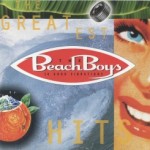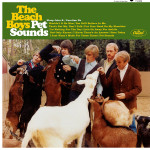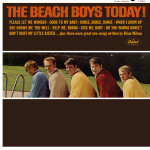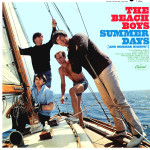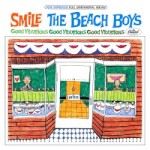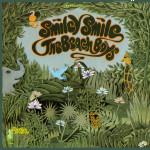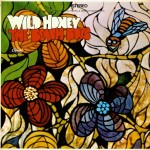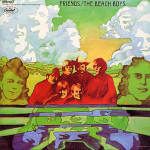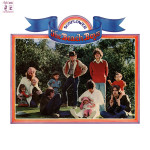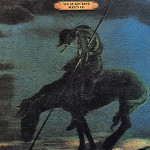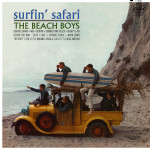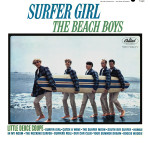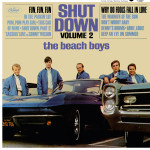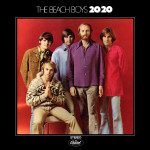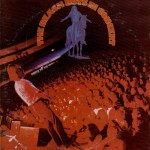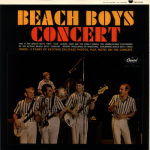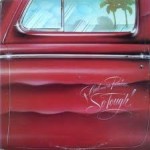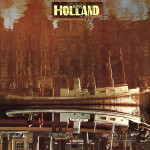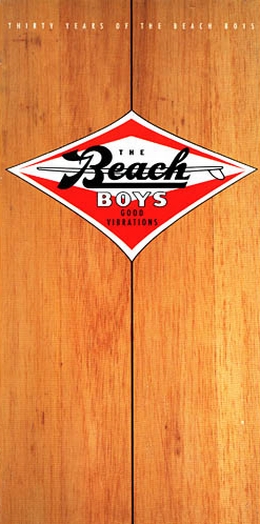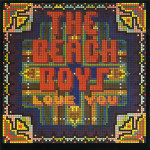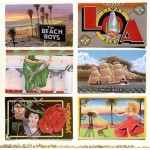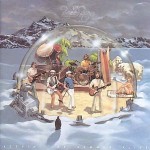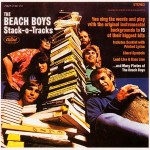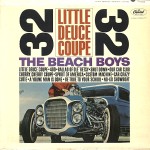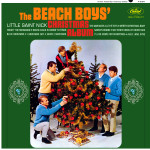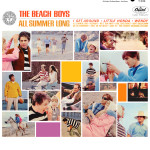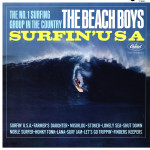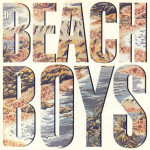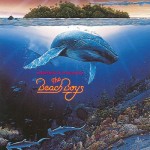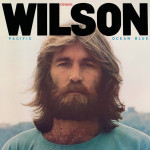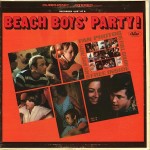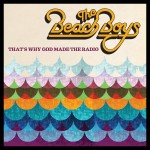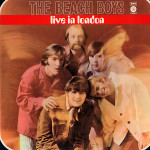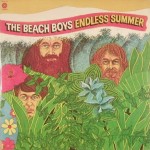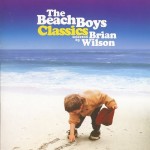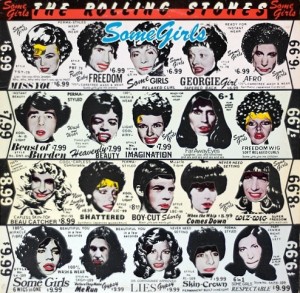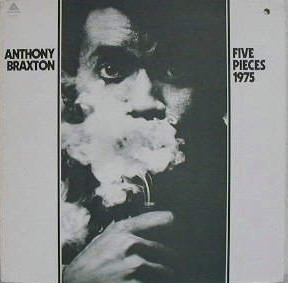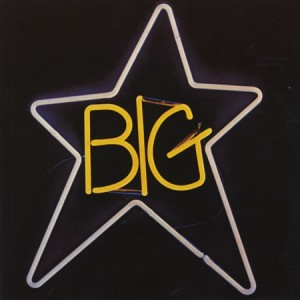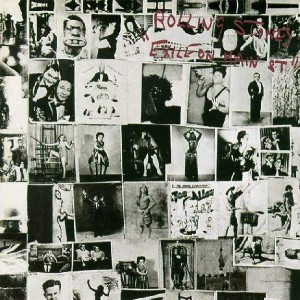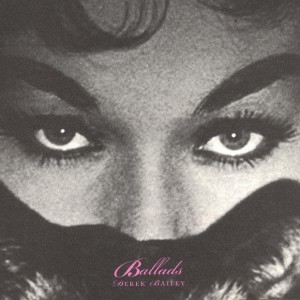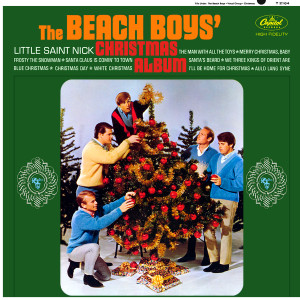 |
Well, if you live in the United States at least, The Beach Boys are so ubiquitous on the radio, on the TV, and everywhere, that you’ve probably heard most or all of these songs somewhere before. So that’s where we’ll begin this tour through The Beach Boys catalog. I don’t think this specific compilation makes a particularly representative overview of the group’s whole career, but it is just what it claims to be: a gathering of the group’s biggest hits. So I’ll assume you already know The Beach Boys as a vocal pop band, kind of focused on surf music and catchy fun-in-the-sun tunes. Well, that’s only the beginning… |
 |
The classic Pet Sounds is the place to start if you want to get to know The Beach Boys. It was then-bandleader Brian Wilson‘s coming of age epic. If you are at least in your mid-to-late teens or early twenties, then chances are you’ll connect with something on this album. It’s a lot more introverted that most of the band’s biggest hits (yeah, I know you know those already). But as we’ll see a little later on, introverted songwriting is a big part of what made Brian Wilson a pop music genius. A bonus with this album is that it features a guest, hired-gun lyricist (Tony Asher), who tremendously bolsters Brian’s sometimes undeveloped lyrical sense. However, if you think this is the best album The Beach Boys ever made, you need to read on, because we’ll get to that later… |
 |
Okay, so we’ve touched on the vaunted Pet Sounds already, so it’s time to go back and pick up on a few earlier albums that led up to it. Frankly, The Beach Boys started out as a teen group and their early albums are very thin. Often pushed to release albums of mostly uninteresting filler, their earliest hits are best heard apart from the early albums (and you’ve heard the hits before!). The Beach Boys Today! is one of the best–probably THE best–of the pre-Pet Sounds albums. You can actually hear the group starting to hit their stride with the full-fledged orchestrated pop that made them great on songs like “Please Let Me Wonder” and “She Knows Me Too Well” that populate side two. But you also get a shot in the arm of fun pop songs on side one, like “Dance, Dance, Dance” and “Do You Wanna Dance.” But what you shouldn’t overlook is the original album-only version of “Help Me, Ronda” (it’s spelled differently than the more popular later version), which is perhaps the best version the group recorded. This album is helped tremendously by the fact that session musicians like Hal Blaine were being used on the records by this point, so that the boys could focus on the vocals. |
 |
Another nice little album that pre-dates Pet Sounds is this one. Although people criticize it for lacking any kind of cohesive vision, it does certainly have a lot of great songs: “California Girls,” the slightly Beatlesesque “Girl Don’t Tell Me,” the best-known version of “Help Me, Rhonda,” and “Let Him Run Wild.” While there are some throwaway tracks here–the bane of the earliest Beach Boys albums–lots of the “filler” is quite enjoyable, if straightforward, vocal pop. |
 |
We’ve gotten through a few discs now. The truth is, though, you’re probably still listening to Pet Sounds. Actually, you should be, it’s just that good. Well, you’re probably also starting to wonder “How could they follow this up?” At the time, answering that question seemed to trouble Brian Wilson quite a bit too. The planned follow-up was SMiLE. The project, perhaps the most ambitous pop album ever attempted to date, never really came to fruition. Van Dyke Parks, a brilliant lyricists with surrealist tendencies, was brought in to pen the words for Brian Wilson’s music. With some great songs in hand, recording began. But, for whatever reasons (there were probably many), Brian Wilson broke down before the album could be completed and the project was shelved. Of course, one song–the most expensive to record in history–did emerge as a single: “Good Vibrations.” So this album remained a mystery. Instead, Brian retreated to his house. He built an indoor sandbox in his living room. He drained his swimming pool and set up recording equipment in it. From the safety of his own home, and with a few (very few) snippets and songs from the SMiLE sessions, Brian Wilson had The Beach Boys record their next album to actually see release. Smiley Smile. Fast forward a few decades, well, almost four decades actually. Brian is back, and he has released a newly-recorded solo album called Presents SMiLE, after revisiting fragments of the original recordings. He even tours to support that effort. But then, another seven years later, comes the surprise of The SMiLE Sessions. It’s not new recordings of the old songs. These are the old recordings stitched together. At last! Hallelujah! The holy grail of 60s pop! Well, er, almost. No doubt, this is a classic, even decades late. The orchestration soars, the tunes, magnificent. Yet there’s also something not quite right in some of the digital manipulations used to pull together the unfinished recordings for the original album. It’s minor quibble altogether, but it’s one reason not to start your Beach Boys journey here. You’re gonna have to make this a stop on it though. The sunshine daydreaming, the childish mythology, the druggy schizophrenia, the historical compendium-building, the christian moralizing, the hopeful irreverence–The SMiLE Sessions are all that and more. This must be called something other than simply SMiLE, but a newcomer is probably best served sticking to the presentation of the “original” album and skip the bonus tracks (for now), so as to bask in the wonderful vision and not turn it into something tedious. |
 |
Smiley Smile. To some it is an unmitigated disaster. But it’s my favorite Beach Boys album. If you hate this album, you are probably going to have a pretty different opinion about most of the rest of the catalog (although there might be a few places we agree a little at least). But anyway, this is about as “out there” an album as The Beach Boys ever made. It’s dark at times, full of surreal imagery, and creative as hell. The recordings are a little coarse at times (remember the recording equipment in the swimming pool?). Still, “Wonderful” anticipates Sonic Youth‘s “Little Trouble Girl” by almost three decades. Good luck finding any cut-up mix of eclectic sounds like “She’s Going Bald” anywhere from the same time period, or anything as good from any later period. And “Little Pad” is a perfect statement of the kind of romanticized, dreamy songwriting that from here on out will separate the Brian Wilson fans from all the others. We also have the poppy “Vegetables”, the peppy “Gettin’ Hungry”, and one of the very best ballads the group ever recorded in “With Me Tonight”. And you know, “Whistle In” has the kind of stream-of-consciousness diary-like quality that wouldn’t surface anywhere significant until Mark E. Smith and The Fall resurrected it almost two decades later. But I digress. Needless to say, I for one find the most wildly innovative ideas in the whole Beach Boys catalog on this album. If you want refinement, you’re better off looking elsewhere (like the Kenny G discography). But like I said, this one remains my favorite for its dense, inscrutable charms. |
 |
So this, the follow-up to Smiley Smile, was probably another surprise for those trying to anticipate what The Beach Boys would do next. Wild Honey was the most stripped down, rocking album the group had made yet. The driving title track would become a concert favorite in the coming years (particularly with Blondie Chaplin to play it, but more on him later). This album brought The Beach Boys back into critical regard somewhat, and it inspired a lot of other artists to adopt a more stipped-down recording style too. But really it’s quite simply one of the nicest, most enjoyable and listenable Beach Boys albums around. No, there are no hits you’ll ever hear on the radio (even Smiley Smile ended up including “Good Vibrations”). But the mellow, soulful sound here is just real nice. Later, under Brain’s brother Carl Wilson’s direction, the band would return to a more soul-influenced sound, but the results then would never come close to the heights of Wild Honey. |
 |
Okay, having some familiarity with the hits behind us, the praised Pet Sounds and some very good earlier albums, as well as the travails of SMiLE and its progeny also behind us, it’s finally time to get to probably the best Beach Boys album. Virtually unknown outside of the realm of Beach Boys fandom these days, Friends is the group doing everything at their peak capacity. The songwriting is phenominal. Songs written with Van Dyke Parks for the SMiLE sessions are still showing up here in force. Dennis Wilson even contributes his songwriting for the first time. And if Pet Sounds is a coming-of-age album, this is the one about fully arriving at adulthood. While I’ve driven home the great songwriting already, the songwriting here is really only part of the story. Brian Wilson produced all the Beach Boys material during this era. His talents in producing recorded music were the best this side of Sly Stone. Brian could absolutely perfectly balance instrumentation, timbres, rhythm…heck…EVERYTHING that goes into a recording, that it just astounds me every time I hear this album. But you don’t have to really get into all that to enjoy this album. This is just one of the best pop albums I can think of. It has zero hits you’ll ever hear on the radio (yet again). But I do think part of why people ignore this album is also due the fact that it’s one that largely revolves around reaching adulthood, and let’s face it, that never really happens for a lot of people, or at least they are done listening to pop music by the time it does happen. In that sense, I can understand how some won’t relate. So this one slipped through the cracks. But as Bob Dylan supposedly once said at a Beach Boys concert, “You know they’re fucking good, man.” True. |
 |
A good effort for the 1970s Beach Boys. This album has held up better than most from the era. But clearly, they had lost a step by this point (don’t believe the fan hype surrounding this one). The best tracks are the ones with the most input from Brian, like “This Whole World.” You can feel the schmaltz creeping in here though. |
 |
Here’s an album on which I disagree with a lot of Beach Boys aficionados. I think this is a pretty marginal album. Of course, it does have some essential tracks, namely the closers “‘Til I Die” and “Surf’s Up.” I guess for that reason it can’t be missed. Really, the title track here is one of the very best Beach Boys cuts from any era. But the other stuff, like “Long Promised Road” and “Feel Flows,” are really only mediocre. Plus, we have the return of worthless filler like “Disney Girls (1957)” and “Student Demonstration Time.” Well, all things considered this still beats a lot of other albums… |
 |
Time to come back to reality. Here’s the first ever Beach Boys album. It’s an almost totally forgettable assemblage of filler, with the title track and their breakout single “Surfin'” thrown in. I put this here on the list so that we remember to appreciate how good things were in the late 1960s and into the early 1970s. |
 |
This is a huge step up from the group’s debut album. We’ve got more hits here. “In My Room”, “Surfer Girl” and “Little Deuce Coupe” were big advances in songwriting. But still a lot of filler. |
 |
This mysteriously titled album (there is no “Vol. 1”) makes a few more advances in songwriting with “Don’t Worry Baby” and “The Warmth of the Sun”, and includes the popular “Fun, Fun, Fun.” I think it’s at least as good as Surfer Girl. But still too much throwaway filler! In fact, much of this is far worse than just throwaway filler. “Denny’s Drums” is rightly the butt of many Beach Boys jokes, and “‘Cassius’ Love vs. ‘Sonny’ Wilson” is just as bad. |
 |
Okay, back to some stronger material. Well, 20/20 isn’t really a cohesive album-length statement like most of the mid-to-later 1960s albums, but it has more good songs than most of the early albums. With the nostalgic fun times hit “Do It Again,” the unique rocker “Bluebirds Over the Mountain,” the Brian Wilson sleeper “Time to Get Alone,” the song supposedly originally written by Charles Manson and the Manson Family “Never Learn Not to Love,” and some more SMiLE leftovers in “Cabinessence” and “Our Prayer,” this one is all over the map. But even so, and even if this release was kind of an attempt to clear the vaults, there are still a lot of good songs present here. You need to hear this at some point. |
 |
I like to think of this as one of the hidden gems in the Beach Boys catalog. Coming as a live album in the early-to-mid 1970s, it doesn’t look promising on paper. Brian had stopped touring with the band long ago, and he really wasn’t doing much at all, if anything, with band at this point. And Mike Love was long an advocate of milking the summer fun hits that were easy to perform live (he got his way soon enough). But here, we actually get a lot of great, more complex songs. Even the rambling “Heroes and Villains” from Smiley Smile appears. And a few of the versions of songs from the early 1970s studio albums (“Marcella”, “Leaving This Town”) sound better live than on the studio originals. The value of newish members Blondie Chaplin and Ricky Fataar is clear. Their contributions, though their songwriting is maligned by some, are far superior to wholesale crap like “The Nearest Faraway Place” offered on 20/20 by departed member Bruce Johnston (good riddance! But he would return). I guess you have to like The Beach Boys by this point, and need to have heard some of their poorer albums, to really appreciate this album. It may not be great, and I wouldn’t quite call it essential–it comes close though. But if you have made it this far and are still intrigued, you’ll really enjoy this one. It’s a nice little reminder of why Bob Dylan made his “famous” comment that I mentioned above. |
 |
Okay, this has a wide reputation as being a pretty bad live album. It’s not wholly terrible, but it’s not good either. It has serviceable versions of a few of their early hits, some generally poor covers, and an unfortunate amount of instrumentals–never one of the group’s strengths. You probably don’t even need to listen to this. But by way of contrast, it does show how welcome The Beach Boys In Concert was as a live entry in the catalog. |
 |
When Brian went pretty much into full retirement, his brother Carl Wilson took over the duties of producing the records. He’s in charge here, as the title suggests. Also, with this album, we first hear the new South African members Blondie Chaplin and Ricky Fataar. This is a pretty disappointing record. It has a few decent cuts, without having anything particularly memorable. The soulful blues rock of “Here She Comes,” written and sung entirely by Chaplin and Fataar, is something totally new for a Beach Boys record. It’s a good cut to fool someone with in a blindfold test. Brian’s “You Need a Mess of Help to Stand Alone” may be the best here. But “Cuddle Up,” with string arrangements from Daryl Dragon of Captain and Tennille “fame” is just awful. I don’t want to hear any of this “but it’s a touching performance by Dennis” crap. That shit blows and y’all should know better. |
 |
The Beach Boys were clearly in trouble by this point. They really weren’t very popular anymore, and their last few albums had been decreasing in quality. Some see Holland, which was recorded in the Netherlands, as a comeback album. I’m not one of those people. It’s okay. I think it’s a little better than Carl and The Passions, but not by much at all. Of course, what we have for the album opener is really the last of the leftovers from Brian‘s collaboration with Van Dyke Parks in “Sail On, Sailor.” It’s one of the few really great songs The Beach Boys recorded in the 1970s. The “California Saga” medley starts out fine with the “Big Sur” segment, but it has some dismal lows by the time it wraps with Al Jardine‘s “California” segment. There are some interesting moments elsewhere, but this really is a disappointing album. |
 |
A free bonus EP included with Holland. It’s an unusual child-like spoken word piece set to music. You guessed right if you think this one is all Brian. Actually it’s a fascinating concept, and the background music is quite good at times. But the band manager Jack Rieley does the narration without any spirit, and Brian’s words are clumsy at times. Conceptually, this is way more interesting than Holland itself. It comes across as a little half-assed. I still like it. |
 |
Okay, it took us a while, but we have pretty much made it through the release of most of the leftover songs from SMiLE on later recordings. Now, at first glance this box set might seem totally unnecessary, as we have already made it through a slew of Beach Boys albums as part of this list, not to mention all the hits you know from the radio. But this isn’t what I would call a conventional box set. Yeah, it’s got most or all of the big hits here, but the reason huge fans will need to look into it at this point is the fact that it contains most of the previously unreleased outtakes from the SMiLE recording sessions in piecemeal form. That includes a great solo rendition of “Surf’s Up” by Brian at his piano, and all the bits of songs that had been eventually renamed and recycled through the early 1970s. You could, if so inclined, even make your very own SMiLE bootleg! It’s a hobby that has maybe lost some luster after not one but many incarnations of the album have been officially released, but no serious fan is going to take releases from forty years later at face value; those brave few are going to fix something, even if they have to break it first. |
 |
If you enjoyed The SMiLE Sessions, it may be worth finding the Brian Wilson Presents SMiLE solo version too. Now, some of you will complain that Brian’s new backing band The Wondermints are nothing compared the original Beach Boys. And some of you will say that these songs, and the album as a whole, seem a bit more concise and streamlined than what had been reported about the aborted original album suggested. And a lot of you will probably find this rendered completely superfluous by The SMiLE Sessions. Well, feel free to complain. If you’ve made it this far down the list, you’ve earned the right to bitch and moan a little. But apart from what this album could have been or whatever, this is still some great music. It is a little out of place 40 years after it was written, but that shouldn’t matter. I was lucky enough to go to the first ever live performance of the album in the United States (me and a slew of middle-aged men wearing tacky Hawaiian shirts). This recording didn’t entirely live up to the live performance for me, but I still like it. |
 |
This was billed as a great “comeback” for the band. I find it to be a practically unlistenable piece of garbage, with the exception of “Had to Phone Ya.” This was an unmistakable sign that the band’s best times were over. The title refers to 15 big turds, er, crummy tracks. |
 |
Originally a Brain Wilson solo effort converted into a Beach Boys record. Fans like this one for its weirdness and the fact that Brian was back in form, musically. Still, Brian was working without the aid of a lyricist, and so we get a lot of garbage in that department, like a song about Johnny Carson with the line “when guests are boring he fills up the slack.” In spite of the weak lyrics, the goofiness of this is charming, and fun. Chronologically, this is probably the last Beach Boys album worth bothering with. |
 |
After Love You, this one was a disappointment. The group isn’t trying very hard, and seems to be just going through the motions listlessly. They hit some pretty low points toward the end of the album (“Match Point of Our Love,” which actually sounds worse than its title!). Still, there are a few halfway decent songs here and most of the album is serviceable, if fairly nondescript and bland. Highly committed fans might get something small from this album, but it is not of general interest. |
 |
An album emblematic of The Beach Boys’ descent into soft rock purgatory. Most of this is so bland it drifts by without notice, with the better tracks (“Good Timin’,” “Angel Come Home,” “Baby Blue”) not really good enough compared to their best material to cause that much of a stir and the bad tracks (“Here Comes the Night,” “Shortenin’ Bread”) so forced it’s embarrassing. At this point it became clear that no matter how hard the group might try, they simply weren’t going to be able to be truly relevant anymore. Still, the album is listenable for the most part, and fans of the slower material on the group’s various other 1970s albums might like it. |
 |
By the 1980s, The Beach Boys hardly seemed relevant anymore. Yet Keepin’ the Summer Alive has a few good tunes, including the title track. This is better than the last couple albums, and better than anything that came later. But it also casts the Boys as grumpy old timers desperately trying to summon up the past rather than looking toward the future. |
 |
This is an album full of instrumental versions of the band’s hits. So it’s billed as basically a karaoke album. A novelty item. |
 |
Another novelty. This album features almost entirely songs about cars. The best songs had previously been released on other albums. Not much of interest new here. A by-product of the ridiculous rush to put out “new” albums at too quick a pace. |
 |
Wrapping up the novelty entries in the catalog (pun intended), we have the christmas album. It is short, at less than thirty minutes, but has the classic “Little Saint Nick” and some other good songs (“Merry Christmas, Baby,” “We Three Kings of Orient Are”). It is a novelty though, and nothing essential. Yet the boilerplate, Sinatra-esque orchestral backing utilized at times here may have pointed the way to more satisfying efforts that expanded on those kinds of ideas like The Beach Boys Today!, Pet Sounds, etc. The Beach Boys came back to christmas music in the 1970s with a single “Child of Winter” and then another whole album that was rejected by their label and not originally released–at least some of that material was later released on Ultimate Christmas. |
 |
I needed to hold something back on the list so that the tail end doesn’t seem like just a bunch of marginal later efforts and oddities. This one is another step up from Surfer Girl and Shut Down, Vol. 2, and was their best album up through that point. But it is still a distinct step down from the very best albums in their catalog with the ever present bother of filler from which the early albums never escape. But this one is pleasant, and can be handled all the way through. It’s appropriately titled. |
 |
Their second album has the horrid ripoff of Chuck Berry‘s “Sweet Little Sixteen” in “Surfin’ USA.” Nothing too exciting here. |
 |
This was something of a reunion album after the death of Dennis Wilson. Unfortunately, the album spawned a hit song, which probably encouraged the group to keep going well beyond their prime. Anyway, this one makes extremely overt attempts to sound current, complete with lots of mid-1980s synths and drum machines. Apart from the two mediocre songs that open the album, this could be classified by the UN as cruel and inhumane treatment of its listeners. This is one of those albums that plays in the waiting room to hell–as the universe sadistically waits for you to realize that you are already there. |
 |
This one has that song “Kokomo,” which I HATE. And die hard fans insist that it is the best song on this album (I haven’t heard it fortunately). Mike Love was fully in control of the band by this point. Clearly, he had successfully killed the dream. Surely, the band could sink no lower…. |
 |
I think everyone with functioning ears would have been happy if The Beach Boys just hung it up after Love You or even L.A. (Light Album). But instead, we have a parade of worthless junk tarnishing the catalog from the 1980s onward. An album like this with John motherfuckin’ Stamos singing Dennis Wilson‘s “Forever” is perhaps the lowest of the low for the band (though, admittedly, it’s not that bad, and even better than some of the stuff the band proper was up to at this point). Although, with some of the original members still alive (Mike Love, Al Jardine…looking in your direction) I won’t hold my breath on that. |
 |
The one solo album Dennis Wilson completed before his drowning death. This makes the list to redeem that John Stamos track from Summer in Paradise, because it’s a fine album that is as good or better than anything The Beach Boys did from the 1970s forward. Also be sure to check out Dennis in the great cult film Two-Lane Blacktop (1971). |
 |
A quickly tossed off album that few seem to like. It’s actually much better than it seems. Despite a lack of Brian Wilson originals, covers of the likes of The Beatles are choice. There is a lot of energy here, and it’s a fun listen from beginning to end. The vocals and instrumentals aren’t polished, but that’s part of what makes this feel as lively as it does. Beach Boys’ Party! is worth giving a chance for anyone with an interest in the band’s pre-Pet Sounds period. |
 |
A really late career comeback album that’s a roll-back to the group’s Pet Sounds-era music in many ways. The lyrics are corny and there is definitely something artificial in the mix, particularly a feeling that the vocals are electronically processed, but this has touches of what made the group so great in their prime (*ahem*, Brian). If you’ve exhausted everything else in that vein from the early years and still want more this is a better place to look than other post-1980 releases. |
 |
Some claim this live album is the group’s best. I haven’t heard it to judge for sure. |
 |
In the midst of Brian Wilson‘s retirement from the band, and capping a commercial dry spell, Mike Love helped put together this collection of almost entirely pre-Pet Sounds hits. The album, along with a follow-up named Spirit of America, was successful in terms of selling lots of copies. In a way, Endless Summer helped define The Beach Boys’ presence on oldies radio. This is the fun-in-the-sun side of the band that can indeed be a lot of fun, but I feel like it’s a little narrow in its scope and range. That’s exactly why oldies radio gravitates to these hits (when’s the last time you heard a sad song on an oldies station?). But these kinds of songs aren’t what bring me back to Beach Boys recordings often. |
 |
This is the most interesting Beach Boys compilation that I’ve seen. The tracks were selected by Brian Wilson, and he focuses on a lot of his own best songs. For me at least, it’s those songs that I find myself wanting to listen to again and again. There are a select few of the summertime hits here, but mostly this focuses on the songs you’ll never (or rarely) hear on the radio. By this point in our tour, you’ve really heard everything The Beach Boys have to offer. This disc, or a digital playlist resembling it, is probably what you’re looking to listen to on a regular basis to get a nice cross-section of the entire Beach Boys universe–if your tastes are anything like mine.
I’m going to end the list here. The other stragglers in the catalog just aren’t worth mentioning. Those are for the obsessively completist collectors only, and I’m not one of those (or am I?). |


